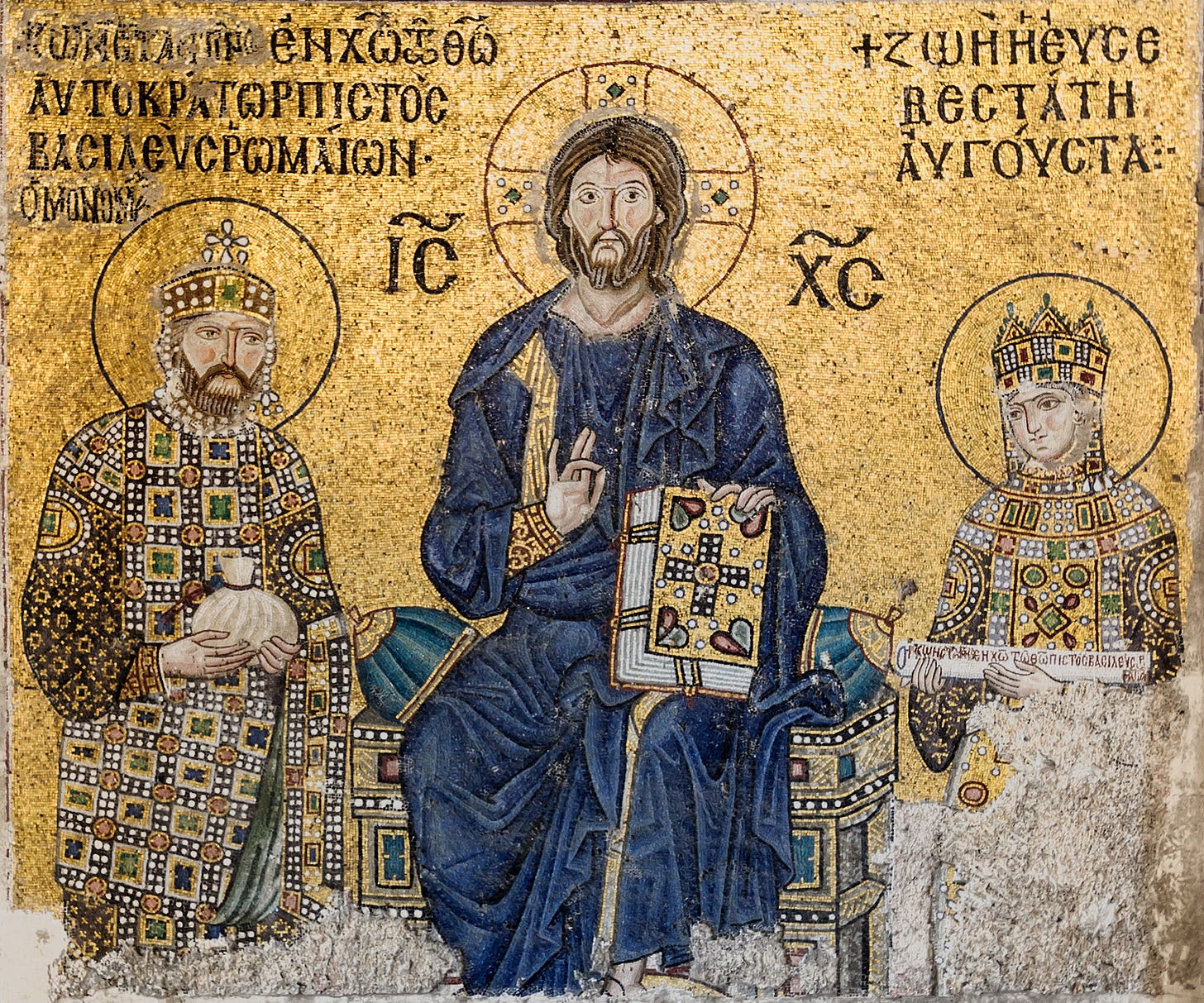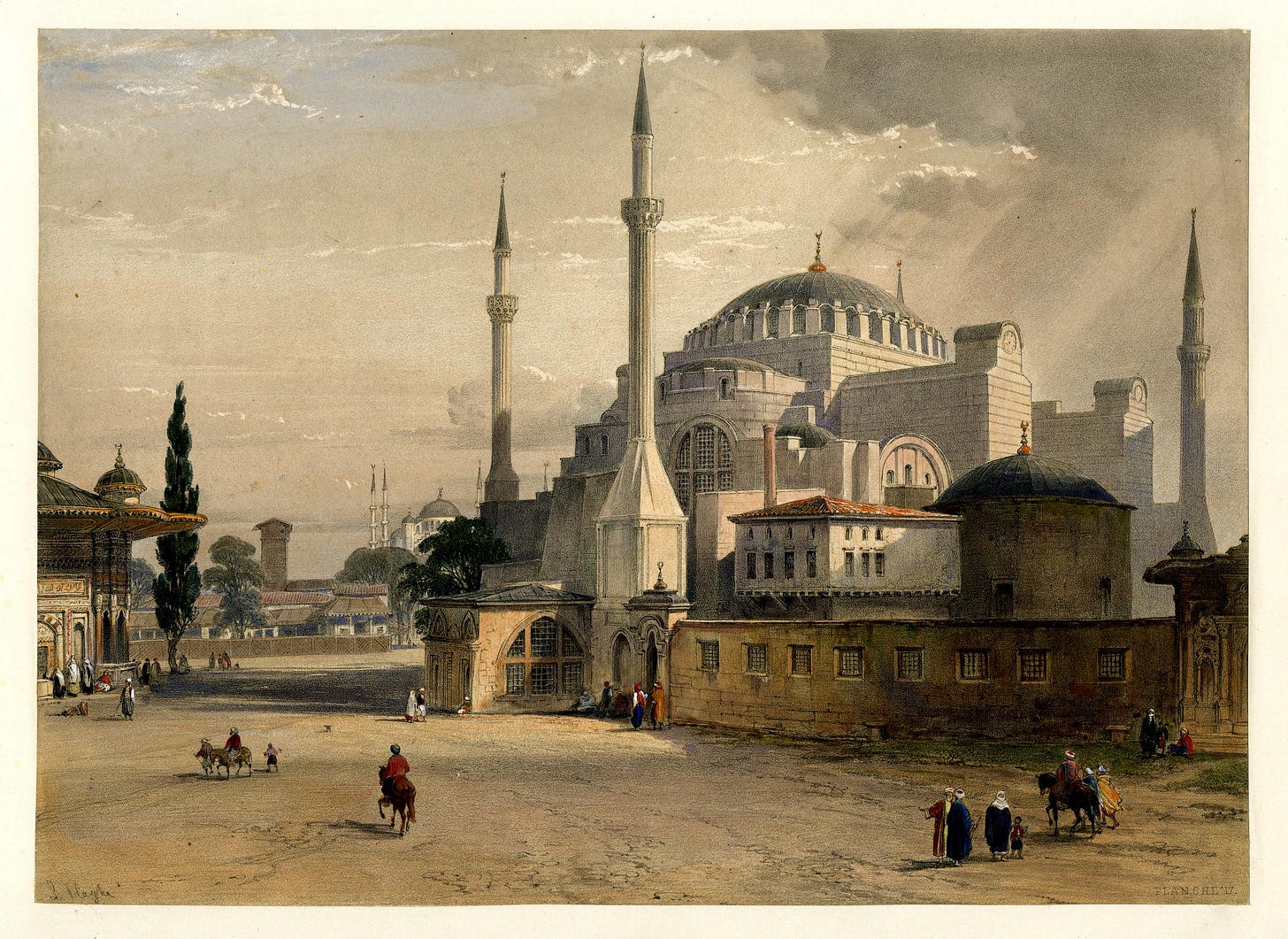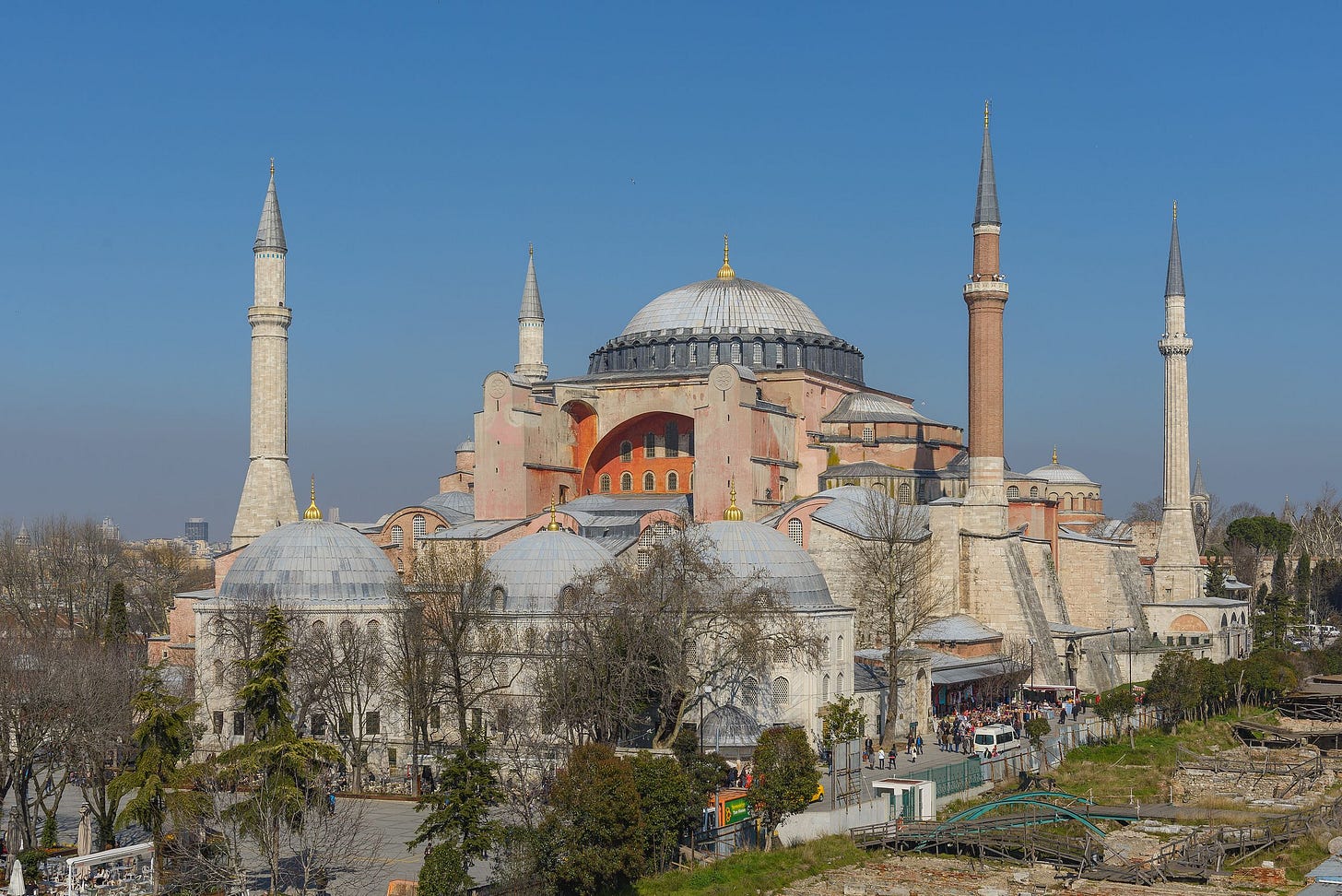I’ve unlocked this essay mostly for people who’ve stopped by from over at Discontents. For access to more essays like this, including FX’s back catalogue, subscribe today:
This essay isn’t based on a subscriber request, but since it’s been in the news recently I had the idea to take a brief look at the history of Istanbul’s Hagia Sophia, or the Ayasofya Mosque if you prefer. One of the most important buildings ever constructed, both in terms of its prominence and its design, the Hagia Sophia has for nearly 1500 years been the jewel of a city that served as the capital of two massive empires. That’s quite a legacy.
It’s commonly known that it was Emperor Justinian I (d. 565) who commissioned the building of the modern Hagia Sophia in the sixth century. But the modern Hagia Sophia (the name means “Holy Wisdom” in Greek) was the third church to stand on that site. The history of the site prior to Justinian can be found in French Byzantinist Raymond Janin’s La Géographie Ecclésiastique de l’Empire Byzantin, though if your French is anything like mine you’ll be looking elsewhere. There’s a nice little book called Hagia Sophia: A History written in English by an author named Richard Winston, who along with his wife Clara was one of the most prolific translators of German writings into English in the 20th century. It’s not perfect, but this is a pretty niche topic and as far as I can tell it covers the basics appropriately.
We know that the first Hagia Sophia, perhaps better known as the Magna Ecclesia or “Great Church,” was completed in 360, during the reign of Emperor Constantius II (d. 361). What we don’t know for certain is whether Constantius commissioned its construction. There are indications that his father, Constantine I “the Great” (d. 337) may have commissioned it, but the record is not conclusive. Constantine did have several churches (and pagan temples, it should be noted) constructed as he was building up his grand new imperial capital, including the nearby Hagia Irene (“Holy Peace,” also known as the Ecclesia Antiqua or “Old Church”), which unlike the Hagia Sophia was [SPOILER ALERT] never converted into a mosque. It got to serve as an Ottoman armory instead, fairly ignominiously, though it does survive to the present day and is a museum now.
Constantius’s church was destroyed by an angry mob—a fairly common occurrence in Byzantine history—that formed after Emperor Arcadius (d. 408) deposed and exiled the popular archbishop of Constantinople, John Chrysostom (d. 407), in 404. Its remains were lost to history. Arcadius’ son and successor, Theodosius II (d. 450), commissioned a new Magna Ecclesia/Hagia Sophia to be built on the same site in 415. Some of its marble blocks have survived, but the full church was burned down by another angry mob (told you) during the infamous Nika Riots in 532. Justinian quickly ordered the construction of a new church, but he demanded something more than a simply rebuilding of the previous structure. Indeed, Justinian wanted the grandest basilica in the world, which is what he ultimately got.
In case it’s not obvious I am not an architect, so I can’t really tell you all the interesting features that go into making the Hagia Sophia one of the most striking buildings in all of Europe and the largest cathedral in Christendom until it was surpassed by Seville’s cathedral in the 16th century. It was the first building known to employ its specific type of dome and was, when it was built, believed to hold the largest interior space in the world, making the dome’s construction all the more impressive. It’s considered the archetype of Byzantine architecture, which is pretty amazing considering the empire continued on for about 900 years after its construction. It was completed in 537, though earthquakes in 553, 557, and 558 caused cracks in the dome and eventually caused part of the building to collapse. The collapse exposed some flaws in the initial design and construction process, so the rebuilding process was in fact a significant renovation that raised the height of the dome and used lighter materials in its construction. The building was reconsecrated in 562. Justinian’s successor, Justin II (d. 578, abdicated in 574), commissioned the cathedral’s first mosaics.

The history of the Hagia Sophia is to some degree the history of the Byzantine Empire, which is a bit too expansive to cover in whatever space we have left. Its images and icons came and went during the first period of iconoclasm in the late 8th century, and then the backlash, then the second period of iconoclasm in the early 9th century, and the backlash to that. It was brutalized by the soldiers of the Fourth Crusade in 1204 and then served as a Catholic cathedral during the Latin Kingdom period, which ended with the Byzantine restoration in 1261. The Palaiologos dynasty, which restored the empire, invested heavily in restoring the cathedral, which had definitely seen better days by the time the Latin Kingdom came to an end. And there were earthquakes. So many earthquakes. Each weakened the structure and many caused parts of it to collapse. The Byzantines always rebuilt, and ultimately these renovations continually strengthened and improved on the original structure, as well as adding new artwork and other features to it.
Its relatively brief interlude as a Catholic cathedral aside, the Hagia Sophia had remained the preeminent house of worship in Orthodox Christianity from its completion in 537. Until, of course, the Ottomans showed up in 1453. During the siege the Hagia Sophia served as both a refuge and a place for residents to pray for deliverance. It’s said that priests continued administering rites in the cathedral right up to the point when Ottoman soldiers burst through the doors. According to legend, the two priests performing services in those final moments vanished, to reappear when a Christian army finally regained Constantinople from the Muslims. If that’s true then those guys have been stuck in limbo for a really long time now. I hope they get cable in there or wi-fi, something.
Whatever pillaging went on in 1204 was probably nothing compared to what the Ottoman soldiers did, although to be fair the degradation of the Byzantine Empire and another series of earthquakes had left the cathedral in pretty dismal shape to begin with, at least according to a number of 15th century visitors to Constantinople whose accounts have survived. Sultan Mehmed II “the Conqueror” (d. 1481) claimed the building and almost immediately had it converted to a mosque. Just as he knew Constantinople was the capital the his empire had been missing, he surely understood the significance of making the grandest cathedral of the Byzantine Empire into the grandest mosque of the Ottoman Empire. In the process of conversion, the cathedral’s movable artifacts and relics were removed and much of its mosaic and marble artwork, deemed unacceptable because of Islamic prohibitions on depictions of the human form, was covered in plaster.
Mehmed invested in restoring the Ayasofya (as it’s known in Turkish) to a degree that the late, decaying Byzantine Empire simply hadn’t been able to do, establishing a religious endowment (waqf) to provide a steady stream of money to finance renovation and upkeep. The structure’s final major architectural features, its four minarets, were added over time. An initial, wooden minaret constructed by Mehmed no longer exists. The red minaret was probably built by Mehmed’s successor, Bayezid II (d. 1512), though it may have been built by Mehmed himself. The other three minarets are built of limestone, but one is clearly skinnier than the other two. That one was definitely built under Bayezid, while the others were built under Selim II (d. 1574), by the most famous architect in Byzantine history, Sinan (d. 1588).
As under the Byzantines, the Ayasofya was restored and renovated several times under the Ottomans, its condition having been eroded by the passage of time and damaged by earthquakes. Its most significant restoration was undertaken under Abdulmejid I (d. 1861) in the late 1840s, led by two Swiss-Italian architects. By that time, though, it had been overtaken as Constantinople’s chief mosque. That honor now rested with the Sultan Ahmed Mosque (aka the “Blue Mosque”), built practically next door in 1616 under Sultan…wait for it…Ahmed I (d. 1617). Ahmed’s reason for building a new great mosque when he already had a perfectly good great mosque was, to be honest, vanity. He commissioned the project in 1609, right after the Ottomans had suffered an embarrassing defeat in the 1603-1608 Ottoman-Safavid War. The mosque was meant purely as a reassertion of Ottoman Exceptionalism, or the 17th century equivalent. And because the Ottomans had just lost the war, it had to be built with treasury funds rather than spoils, which was fairly unusual for Ottoman building projects at the time.

Anyway, I digress. In 1935, the founder of modern Turkey, Mustafa Kemal Atatürk, decreed that the Ayasofya’s use as a mosque be discontinued and that the building be turned into a museum. This served multiple purposes for Atatürk, in that it immediately created a new tourist attraction for his young nation and reinforced his staunchly secular inclinations. The conversion necessitated another restoration project, mostly to remove all the plaster that was covering up the building’s artwork. Another major restoration project was undertaken starting in the late 1990s, with the support of the World Monuments Fund. Over this time, the Ayasofya became one of the most popular tourist destinations in Turkey.
Now it’s becoming a mosque again, with religious services slated to resume there later this month. Turkey’s Council of State, its highest administrative court, ruled earlier this month that Atatürk’s decree was unlawful, and Turkish President Recep Tayyip Erdoğan placed the Ayasofya’s administration under the Turkish government’s religious office, the Diyanet. We’ve covered some of the considerable international condemnation of the move, which in some respects is the culmination of Erdoğan’s hybrid religio-nationalist politics. Erdoğan’s government has been slowly reclaiming Ottoman mosques-turned-museums around the country, though for obvious reasons none of those conversions attracted the attention that this one has. In some ways the international backlash has only given Erdoğan more incentive to keep going, since that way he gets to perform for his nationalist base.
Practically I have no idea what’s going to happen to the Ayasofya now. In the abstract there’s no reason it couldn’t continue to serve both as mosque and tourist destination, as the Sultan Ahmed Mosque does—and, frankly, as bad as Turkey’s economy is these days, there’s incentive for Erdoğan to ensure it continues serving both functions. He’s said the mosque will remain open to the public except during prayer times, which is the general rule throughout Turkey. This is no different from any number of cathedrals and other Christian houses of worship across Europe. There is a legitimate concern about the fate of all the artwork, but there are simple ways to cover those things at prayer times that would still leave them available to tourists at other times.
But until the new status quo is actually implemented there’s no way to determine what the change will really mean for the structure. And as I said in the newsletter earlier this month, Erdoğan’s government doesn’t have a good track record here. Its conversion of the Hagia Sophia in Trabzon has been badly managed, resulting in the destruction of much of that structure’s historical heritage. Obviously the Hagia Sophia in Trabzon is not the Hagia Sophia in Istanbul, and there will be a lot more attention paid to how this conversion is managed. But if past performance is indicative of future results, the future of Istanbul’s Hagia Sophia isn’t looking so great.
Symbolically, there’s something to be said for taking a museum that celebrated the Hagia Sophia’s long history as an iconic Christian and Muslim structure and turning it into a mosque at the behest of a far-right nationalist government that views the building less as a symbol or even as a house of worship than as a trophy of conquest. It’s very 2020 in that way.


